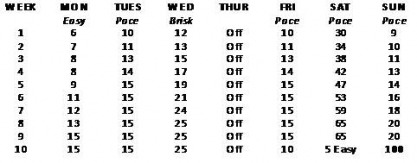|
Cycling season is well upon us and if you are contemplating a century ride (100 miles, or 161 km) this summer it helps to be prepared. Since cycling a century is similar in its endurance requirements to ice skating a long tour and also that cycling is close to skating in its physiological demands, bike century training plans make for a good starting point to arrive at a plan for training for a skating marathon. There are several good sources of information on biking a century. Bicycling Magazine's June 2009 has a century training plan. Another excellent source of information is Ed Burke’s book, The Complete Book of Long Distance Cycling. The book contains not only training plans, but a wealth of other information for the long distance rider and an invaluable source of endurance training insights that can be adapted to an ice skating marathon training program. Here’s a program from the book to just finish a century with the training distances shown and the longest training ride at 65 miles. A similar program to perform better in the ride has a more demanding schedule that builds to a longer training ride of 75 miles (121 km). The training programs for a cycling century or a running marathon generally have several common features:
0 Comments
Leave a Reply. |
Editor - JimThis blog weighs in on topics such as long-distance skating, the Illinois canals, cycling, and a variety of related (and occasionally not-so-related) topics. I'd like to correspond with others interested in skating the Hennepin and I&M canals. Archives
November 2020
Categories |


 RSS Feed
RSS Feed